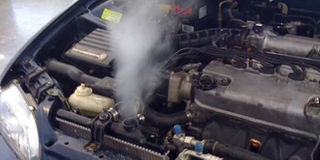Understand your car cooling system

What you need to know:
- The car cooling system, according to Moses Wabomba, a mechanic in Bugolobi, is an important component of the car that has the potential to make the car get stuck in the middle of the road.
- The combustion chamber, where much of the heating and cooling activities happen, heats up to completely vaporise the fuel, providing better combustion and reducing emissions as well as thinning the oil to a smooth layer that allows engine parts to move freely.
Although car engines have improved a lot, they are still not very efficient at turning chemical energy into mechanical power.
Most of the energy in cars that run on fuel is converted into heat, and it is the job of the cooling system to take care of that heat.
The primary job of the cooling system is to keep the engine from overheating by transferring heat into air, some of which is emitted through the exhaust pipe system.
The car cooling system, according to Moses Wabomba, a mechanic in Bugolobi, is an important component of the car that has the potential to make the car get stuck in the middle of the road.
“You have seen cars stop all of a sudden in the middle of the road. And before you know it the engine has switched off and there is a low of smoke or vapour in the bonnet area. This is a result of a malfunction in the car’s cooling system,” he says.
A car’s temperature gauge, according to Wabomba, should never go above the normal mark as anything above that is an indication of a heating abnormality.
After the car has started, the timing linear, for non digitalised gauge systems, moves up to the middle to indicate stable temperature.
This, he says, is ensured through an interlinked system that ensures that part of the burning fuel is emitted to cut back on the heat that is built within the car.
Inside the car’s engine, fuel is constantly burning. A lot of the heat from this combustion goes right out of the exhaust system, but some of it soaks into the engine thus heating it up.
The combustion chamber, where much of the heating and cooling activities happen, heats up to completely vaporise the fuel, providing better combustion and reducing emissions as well as thinning the oil to a smooth layer that allows engine parts to move freely.
According to Ismail Male, an exhaust pipe specialist in Katwe, Kampala, there are two types of cooling systems and these are fitted with outmost safety, which if exposed to damage might have serious repercussions.
The two types, he says, include liquid-cooled and air-cooled system.
Liquid cooling
The cooling system on liquid-cooled cars, Wabomba says, circulates fluids through pipes and passageways in the engine, which absorbs heat thus cooling down parts of the engine.
After the fluid leaves the engine, it passes through a heat exchanger, or radiator, which transfers the heat from the fluid to the air and blows out through the exchanger.
Air cooling
This technology is common among older cars as most of them have been fitted with the liquid cooling system.
Here, according to Male, there is no circulation of fluid through the engine but the engine block is instead covered with aluminum fins that conduct the heat away from the cylinder.
“A powerful fan forces air over the fins, which cools the engine by transferring the heat to the air,” he says.
Free of clogging
The cooling system in most cars which are fitted with the liquid cooling system have a lot of draining and you must always ensure that the system is free of clogging.
In liquid cooling system, the pump sends the fluid into the engine block, where it makes its way through passages in the engine around the cylinders before it returns through the cylinder head of the engine.
Cars operate in a wide variety of temperatures, from well below freezing to well more than 38 C.
So, according to Wabomba, whatever fluid is used, such as water, to cool the engine must have a very low freezing point, a high boiling point, and must have the capacity to hold a lot of heat.
Water is one of the most effective fluids for holding heat and it is more effective in the tropics.
However, in areas that experience winter, it is advisable that a few additives such as ethylene glycol, an antifreeze agents, is added to improve the boiling and freezing points of the water.
Function of a radiator
A radiator, according to Moses Wabomba, a mechanic in Bugolobi, Kampala is a type of heat exchanger that is designed to transfer heat from the hot coolant that flows through it to the air blown through it by the fan. Most modern cars use aluminum radiators, which are made by brazing thin aluminum fins to flattened aluminum tubes.
The coolant flows from the inlet to the outlet through many tubes mounted in a parallel arrangement. The fins conduct the heat from the tubes and transfer it to the air flowing through the radiator.




